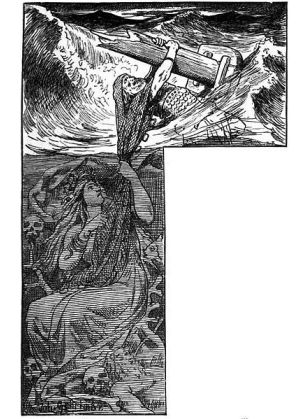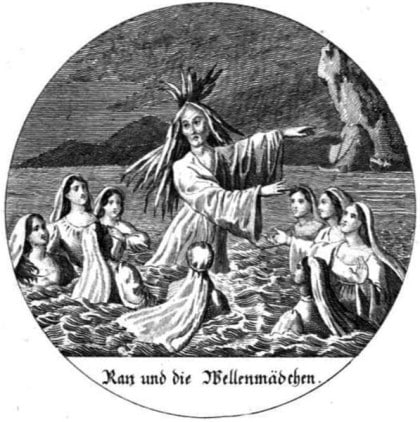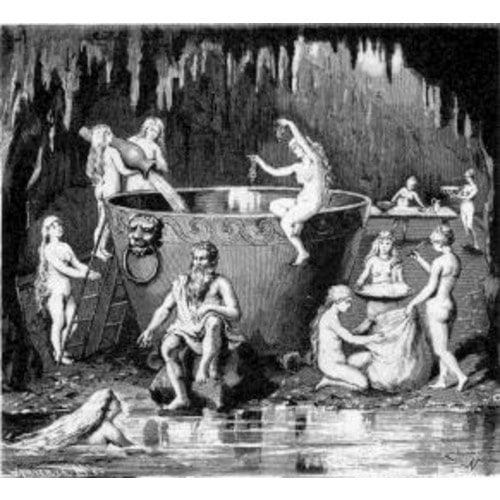A personification of the sea, Ran is one of the most powerful Norse goddesses. She and her jötun husband, Aegir, are the divine powers of the ocean. She creates all the sea storms and is the cause of death for many unfortunate seafarers. With Aegir, Rán has nine daughters, all personifications of waves, and collectively, mothers of the Aesir god Heimdall, by Odin.
Ran’s origins and background is largely unknown, which may have added to the fear many had for her. If you traveled over the ocean, or really even a river, she could be waiting for you with her net. In this article I will try my best to share what I believe are reasonably certain facts, and also discuss a couple of things that seem quite likely.
Ran Short Facts
| Parents | Unknown |
| Partners | Aegir |
| Siblings | None known |
| Offspring | Nine daughters (Waves) |
| Tribe | Aesir or Vanir goddess |
| Old Norse Name | Rán |
| Other Names | None |
| The God of | Sea, Storms |
| Ass. Artifact | Her net |
Name and Origins
The etymology of Ran’s name is as intriguing as her mythological role. In Old Norse, “Rán” translates to “robbery,” “theft,” or “plunder,” a meaning that has endured into the modern Norwegian language. This direct translation offers a glimpse into her perceived character and the fear she inspired. She was the one who ‘plundered’ sailors from the world of the living.
This interpretation of her name is not merely about the physical act of taking, but also carries a deeper, more symbolic meaning. It reflects the very essence of Ran’s divine role. As the goddess of the sea, she ‘robbed’ seafarers of their lives, claiming them with her net and pulling them into the depths of her watery realm. This act of ‘robbery’ is not seen as a mere loss but as a necessary transaction in a grand cycle of life and death. The idea of which was close to what the Norse understood and respected. Ran’s name, therefore, is a powerful reminder of the respect and caution with which the sea—and by extension, the goddess herself—should be treated.
Ran’s Origins
Ran’s parentage remains a mystery, as the ancient texts do not provide us with this detail. She is not known to have siblings either. However, her marriage to Aegir places her firmly within the realm of the sea.
One thing we do know is that she is a goddess. However it is unknown if she came from the Aesir or Vanir tribes. My personal belief is that she came from the Vanir, mostly based on the lack of knowledge about her. Just as we know little about her background, we know little about the background of Njörd, Freyr and Freyja. Other than that they are Vanir that is.
Kennings
Kennings are a distinctive feature of both Old Norse and other Germanic poetry. They are metaphorical phrases or compound words used to describe something, often in a roundabout or indirect way. Kennings replace a straightforward, everyday word with a more complex, evocative image. Usually adding both depth and color to the language of the sagas and eddas.
For Ran, kennings serve to both conceal and reveal her nature and influence. The sea, her domain, is referred to as the “Husband of Rán” when speaking of Aegir. This not only denotes their marriage but also the inseparable connection between the sea’s might and its depths. Similarly, the “Land of Rán” or “Land of Aegir’s Daughters” are kenning for the sea, emphasizing its role as a realm where Ran’s presence is as tangible as that of any land-based kingdom.
Gold, with its lustrous allure, is often called the “Fire” or “Light” or “Brightness of Aegir, of Rán, or of Aegir’s daughters,” linking the precious metal to the luminescence of the sea’s surface or perhaps the gleaming treasures that lie beneath the waves, further entwining the material wealth with the mythic figures.
Ran Family and Relationships
Ran’s family is as vast as the sea itself. With Aegir, she has nine daughters, each embodying a different aspect of oceanic waves.
Nine Daughters of Rán
The nine daughters of Aegir and Rán are as fascinating as the sea’s own mysteries. Each of their daughters names embodying the various aspects of the ocean’s character.
- Himinglæva, “That through which one can see the heaven.” Evoking the image of the sea’s surface when it is calm and clear, mirroring the sky above.
- Dúfa, “The Pitching One.“ Representing the undulating motion of the waves, the rise and fall that speaks of the sea’s unpredictable temperament.
- Blódughadda, “Bloody-Hair.“ Possibly as the embodiment of the red-tinted seaweed, or the twilight hues that tinge the waves at sunset or sunrise.
- Hefring, “Riser.“ The swelling surge, the building momentum of the ocean’s power that can lift vessels or dash them with equal ease.
- Udr, “Frothing Wave.” The white-capped waves that froth at the crest, a sign of the sea’s endless churning.
- Hrönn, “Welling Wave.” The gathering strength of the sea, the swell before the break.
- Bylgja, “Billow.” The rolling wave, the archetypal form of the sea’s motion, powerful and relentless.
- Dröfn, “Foam-Fleck.” The delicate foam that forms on the wave’s surface, a contrast to the might beneath.
- Kólga, “Cooling One.“ Possibly the chilling touch of the sea, the cold that seeps into the bones of those who traverse her depths.
These names are not just appellations but descriptors, painting a vivid picture of the sea’s many faces. The daughters of Aegir and Rán are integral to the Norse understanding of the ocean and its multitude of “personalities”. Each a distinct persona of the vast, life-giving, and life-taking entity that is the sea.
Extended Family
An intriguing aspect of Ran’s family is the potential connection to Heimdall, the watchman of the gods. Heimdall is said to have nine mothers, who are sisters. The ancient texts do not explicitly identify them as the daughters of Ran and Aegir, however the coincidence is striking. The number nine is important in Norse mythology and comes up many times. It would be a strange coincidende if Heimdalls’ mothers aren’t the same as the nine daughters of Ran and Aegir. This connection would both extend Ran’s family ties but also weave her more deeply into the fabric of the Norse mythological world. Moreover highlighting the interconnectedness of the gods and their kin which is so often the case in their families.
Ran’s Role and Depiction
Ran, the enigmatic goddess of the sea and fresh water, holds a domain that is as awe-inspiring as it is feared. Her role in Norse mythology is starkly contrasted with that of Njörð, the god of wealth and the sea’s bounty, and even her own husband, Aegir, who is often seen in a more benevolent light. While Njörð’s influence is associated with prosperity and the wealth of the sea, and Aegir is known for his grand feasts and the ale that flows freely for the gods, Ran embodies the sea’s treacherous and unforgiving side.
Aegir and Ran together represent the full spectrum of the sea’s nature. Aegir’s halls were places of merriment where the gods would feast, symbolizing the sea’s capacity to nurture and sustain life. However, Ran, with her net, was the taker of lives, capturing the souls of those who succumbed to the sea’s wrath. This net, her most iconic attribute, was not for harvesting the ocean’s riches but for claiming those who were lost to its depths.
In Norse cosmology, Ran’s portrayal is a reflection of the sea’s dual nature—calm and nurturing when under Aegir’s influence, dark and deadly under Ran’s watch. Her role among the gods is not one of interaction and mediation, like Njörð, but one of dominion over the sea’s most perilous aspects. She is the embodiment of the ocean’s depths—mysterious, vast, and unfathomable.

Rán Artifacts
The net is the most significant symbol associated with Ran, representing her ability to capture the souls of the drowned. This tool is a poignant reminder of her power and the respect she commands. It actually plays a role in a myth not even associated with Rán, as Loki once borrowed it to catch a dwarf.
Mentions in Ancient Texts
Prose Edda
Skáldskaparmál

The Prose Edda’s Skáldskaparmál section frequently mentions Rán, serving as a vital resource for Icelandic skalds to master skaldic poetry, including the craft of kennings. Importantly, the text employs Rán in various kennings: it names Ægir as “the husband of Rán” and poetically describes the sea as “the land of Rán and of Ægir’s daughters.” Moreover, the Edda creatively links gold to the sea’s splendor, calling it “the fire of Ægir” and “the brightness of Rán,” which evokes the shimmering treasures hidden beneath the waves.
Is is in the last part of the Skáldksparmál, the Nafnathulur that she is listed as one of the goddesses.
Háttatal
In the Prose Edda poem Háttatal, Rán is again mentioned in the context of kennings for the sea and gold. The text emphasizes the connection between Rán and Ægir, and their daughters, to the wealth that comes from the sea. This in despite of Rán’s more ominous association with the drowned.
Poetic Edda
Helgakviða Hundingsbana I
In the Poetic Edda, Rán is mentioned in the poem Helgakviða Hundingsbana I. There she is depicted as a force to be reckoned with at sea. The valkyrie Sigrún aids the ship of Helgi Hundingsbane, helping it escape from the clutches of Rán:
“And Sigrun above, brave in battle, protected them and their vessel; the king’s sea-beasts twisted powerfully, out of Ran’s hand toward Gnipalund.”
Helgakviða Hjörvarðssonar
Another mention in the Poetic Edda is in Helgakviða Hjörvarðssonar, where Rán is referenced during a flyting, a contest of insults and wits:
“‘Ogress, you stood before the prince’s ships and blocked the fjord mouth; the king’s men you were going to give to Ran, if a spear hadn’t lodged in your flesh.'”
Other Texts
Sonatorrek
In Sonatorrek, a deeply personal poem by the skald Egill Skallagrímsson, Rán is invoked in the context of the loss and sorrow of a father for his drowned son:
“Greatly has Rán afflicted me. I have been despoiled of a great friend. Empty and unoccupied I see the place which the sea has torn my son.”
Egill expresses his grief and anger, contemplating vengeance against both Ægir and Rán, for the death of his son.
Völsunga saga
In the Völsunga saga, Rán’s net is mentioned as a tool that Loki uses to capture Andvari. This saga, along with the Poetic Edda, provides insight into the broader narrative functions of Rán within Norse mythology.
Friðþjófs saga hins frœkna
In Friðþjófs saga hins frœkna, Rán is mentioned in a more metaphorical sense, symbolizing the final resting place of those lost at sea:
“Now on Ran’s bed belike Must I soon be a-lying, And another shall be By Ingibiorg’s side.”
This reference to “Rán’s bed” is a poetic kenning for the grave that the sea provides to those it claims.
Frequently Asked Questions
Ran’s net symbolizes her control over the sea and her role as the collector of drowned souls.
The myths do not detail complex relationships with other gods; Ran’s focus was her ocean realm.
Ran’s daughters personify the various states of the sea, from calm to tempestuous.
The myths do not tell us Ran’s fate, leaving her end as mysterious as the seas she ruled.
Play Fun Norse Quiz
Is this article making you even more curious about Norse gods and goddesses? You can satisfy your curiosity by playing a fun Norse mythology quiz. This way, you can test your knowledge about Norse gods and goddesses, as well as fill in some gaps. Good luck and have fun playing!
Don’t forget to try our other games as well!
Featured Image Credit: Friedrich Wilhelm Heine (1845-1921) after an original by Friedrich Wilhelm Engelhard (1813-1902)., Public domain, via Wikimedia Commons

